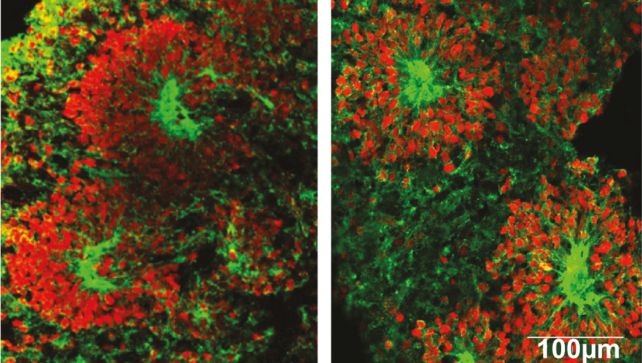Human Minibrains Launched Into Space Thrived in an Unexpected Way
Human minibrains in little vials surprised scientists by surviving a stint in low-Earth orbit.
US researchers sent lab-grown blobs of human neural tissue known as organoids for a short holiday on the International Space Station back in 2019. What they got back a month later amazed them.
Not only were the cells healthy and thriving after weeks of weightlessness – they had matured faster than the same cells here on Earth.
"The fact that these cells survived in space was a big surprise," says molecular biologist Jeanne Loring of the Scripps Research Institute.
"This lays the groundwork for future experiments in space, in which we can include other parts of the brain that are affected by neurodegenerative disease."
The International Space Station (ISS) represents a unique opportunity for research. It provides us with a means to study the effects of microgravity on human cells – which has implications not just for astronauts, which represent a miniscule minority of humans, but also for health research for humans on Earth, and the ISS as a platform for disease modeling and drug development.
A team of researchers led by molecular biologist Davide Marotta of the International Space Station National Laboratory set out to investigate the effects of microgravity on the human brain; specifically the neurons that are affected by neurodegenerative conditions such as multiple sclerosis and Parkinson's disease.
They grew their organoids in a lab using human induced pluripotent stem cells from healthy donors and patients with MS and Parkinson's disease. These are stem cells that are created by taking normal cells from an adult human, and reverting them to a point in a cell's development before it has differentiated into a specific type.
The stem cells were then induced to develop into neurons – specifically the cortical or dopaminergic neurons that are impacted by these neurodegenerative conditions.
Some of the organoids also included brain immune cells called microglia. Such clusters of cells have nothing remotely approaching sentience.
The organoids made of these cells were prepared in specially designed cryovials on Earth, and divided into two groups. Some remained here on the ground; the others were launched into space to spend a month developing in Earth orbit aboard the ISS.

When the organoids were brought back to Earth, the researchers carefully studied them to see how they differed from those that had remained here on the surface.
The fact that the organoids survived and were healthy was a big enough surprise – but there were also marked differences between the Earth-based and space-faring groups, irrespective of whether they were grown from healthy donors or patients with neurodegenerative conditions.
The space-faring organoids had a greater expression of genes associated with cell maturation, but fewer associated with cell proliferation than the Earth-based ones – revealing that the organoid cells replicated more slowly in space, but matured faster.
Another interesting discovery was that the organoids that flew in space expressed fewer genes associated with stress and displayed less inflammation than the researchers expected based on comparisons with Earth-based organoids. This could be because microgravity is closer to conditions inside the human skull than sitting in a vial in Earth gravity conditions.
"The characteristics of microgravity are probably also at work in people's brains, because there's no convection in microgravity – in other words, things don't move," says Loring.
"I think that in space, these organoids are more like the brain because they're not getting flushed with a whole bunch of culture medium or oxygen. They're very independent; they form something like a brainlet, a microcosm of the brain."

This intriguing finding suggests microgravity could be a proxy for conditions that are more natural for brain organoids than the culture vessels on Earth from which they are normally studied. Microgravity could become a laboratory for studying how brain cells react to certain stressors or drugs in conditions closer to what human brains experience in life.
"The next thing we plan to do is to study the part of the brain that's most affected by Alzheimer's disease," Loring says.
"We also want to know whether there are differences in the way neurons connect with each other in space. With these kinds of studies, you can't rely on earlier work to predict what the result would be because there is no earlier work. We're on the ground floor, so to speak; in the sky, but on the ground floor."
The research has been published in Stem Cells Translational Medicine.



